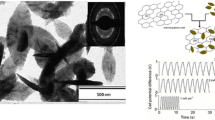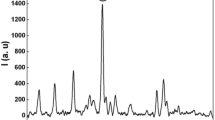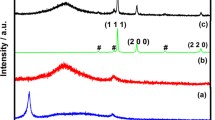Abstract
This work presents NiS/graphene/carbon nanotube (NiS/GNS/CNT) composites as electrode material for the supercapacitor application in sea flashing signal systems. NiS nanosheets were closely anchored on the conductive GNS-CNT networks. As a result, the NiS/GNS/CNT electrode showed a high specific capacitance of 2 377 F·g−1 at 2 mV·s−1 and good cycling stability compared with the pure NiS (1 599 F·g−1). The enhanced electrochemical performances are attributed to the synergetic effect between the conductive carbon and the pseudo-capacitive NiS. The high performance supercapacitor may provide application in the sea flashing signal system.
Similar content being viewed by others
References
Chen CM, Zhang Q, Zhao XC, Zhang BS, Kong QQ, Yang MG, Yang QH, Wang MZ, Yang YG, Schlogl R, Su DS (2012a). Hierarchically aminated graphene honeycombs for electrochemical capacitive energy storage. Journal of Materials Chemistry, 22(28), 14076–14084.
Chen CY, Shih ZY, Yang ZS, Chang HT (2012b). Carbon nanotube/cobalt sulfide composites as potential high-rate and high-efficiency supercapacitors. Journal of Power Sources, 215, 43–47.
Compton OC, Kim S, Pierre C, Torkelson JM, Nguyen ST (2010). Crumpled graphene nanosheets as highly effective barrier property enhancers. Advanced Materials, 22(41), 4759–4763.
Deng DH, Pan XL, Yu L, Cui Y, Jiang YP, Qi J, Li WX, Fu Q, Ma XC, Xue QK, Sun GQ, Bao XH (2011). Toward N-doped graphene via solvothermal synthesis. Chemistry of Materials, 23(5), 1188–1193.
Fan ZJ, Yan J, Zhi LJ, Zhang Q, Wei T, Feng J, Zhang ML, Qian WZ, Wei F (2010). A three-dimensional carbon nanotube/graphene sandwich and its application as electrode in supercapacitors. Advanced Materials, 22(33), 3723–3728.
Geim AK, Novoselov KS (2007). The rise of graphene. Nature, 6(3), 183–191.
He YS, Bai DW, Yang XW, Chen J, Liao XZ, Ma ZF (2010). A Co(OH)2-graphene nanosheets composite as a high performance anode material for rechargeable lithium batteries. Electrochemistry Communications, 12(4), 570–573.
Hummers WS, Offeman RE (1958). Preparation of graphitic oxide. Journal of the American Chemical Society, 80(6), 1339.
Jiang DE, Cooper VR, Dai S (2009). Porous graphene as the ultimate membrane for gas separation. Nano Letters, 9(12), 4019–4024.
Long CL, Qi DP, Wei T, Yan J, Jiang LL, Fan ZJ (2014). Nitrogen-doped carbon networks for high energy density supercapacitors derived from polyaniline coated bacterial cellulose. Advanced Functional Materials, 24(25), 3953–3961.
Paek SM, Yoo EJ, Honma I (2009). Enhanced cyclic performance and lithium storage capacity of SnO2/graphene nanoporous electrodes with three-dimensionally delaminated flexible structure. Nano Letters, 9(1), 72–75.
Wang B, Park J, Su DW, Wang CY, Ahn HJ, Wang GX (2012). Solvothermal synthesis of CoS2-graphene nanocomposite material for high-performance supercapacitors. Journal of Materials Chemistry, 22(31), 15750–15756.
Wang HL, Liang YY, Mirfakhrai T, Chen Z, Casalongue HS, Dai HJ (2011). Advanced asymmetrical supercapacitors based on graphene hybrid materials. Nano Research, 4(8), 729–736.
Wu ZS, Ren WC, Wang DW, Li F, Liu BL, Cheng HM (2010). High-energy MnO2 nanowire/graphene and graphene asymmetric electrochemical capacitors. ACS Nano, 4(10), 5835–5842.
Xiang CC, Li M, Zhi MJ, Manivannan A, Wu NQ (2013). A reduced graphene oxide/Co3O4 composite for supercapacitor electrode. Journal of Power Sources, 226, 65–70.
Xing ZC, Chu QX, Ren XB, Tian JQ, Asiri AM, Alamry KA, Al-Youbi AO, Sun XP (2013). Biomolecule-assisted synthesis of nickel sulfides/reduced graphene oxide nanocomposites as electrode materials for supercapacitors. Electrochemistry Communications, 32, 9–13.
Yan J, Fan ZJ, Sun W, Ning GQ, Wei T, Zhang Q, Zhang RF, Zhi LJ, Wei F (2012). Advanced asymmetric supercapacitors based on Ni(OH)2/graphene and porous graphene electrodes with high energy density. Advanced Functional Materials, 22(12), 2632–2641.
Yan J, Wang Q, Wei T, Fan ZJ (2014). Recent advances in design and fabrication of electrochemical supercapacitors with high energy densities. Advanced Energy Materials, 4(4), 1300816.
Zhang Q, Huang JQ, Qian WZ, Zhang YY, Wei F (2013). The road for nanomaterials industry: A review of carbon nanotube production, post-treatment, and bulk applications for composites and energy storage. Small, 9(8), 1237–1265.
Zhao MQ, Zhang Q, Huang JQ, Tian GL, Chen TC, Qian WZ, Wei F (2013). Towards high purity graphene/single-walled carbon nanotube hybrids with improved electrochemical capacitive performance. Carbon, 54(6), 403–411.
Zhou ZB, Benbouzid M, Charpentierb JF, Scuillerb F, Tang TH (2013). A review of energy storage technologies for marine current energy systems. Renewable and Sustainable Energy Reviews, 18, 390–400.
Zhu T, Chen JS, Lou XW (2010). Shape-controlled synthesis of porous Co3O4 nanostructures for application in supercapacitors. Journal of Materials Chemistry, 20(33), 7015–7020.
Zhu T, Wu HB, Wang YB, Xu R, Lou XW (2012). Formation of 1D hierarchical structures composed of Ni3S2 nanosheets on CNT backbone for supercapacitors and photocatalytic H2 production. Advanced Energy Materials, 2(12), 1497–1502.
Author information
Authors and Affiliations
Corresponding author
Additional information
Foundation item: Supported by the National Natural Science Foundation of China (Nos. 51077014, 21003028 and 51202043); the Fundamental Research funds for the Central Universities, the Program for New Century Excellent Talents in University (NCET-10-0050), and the Excellent Youth Foundation of Heilongjiang Province of China.
Zhuangjun Fan is presently a professor at the College of Material Science and Chemical Engineering, and he is the director of the Institute of Advanced Carbon Based Materials at Harbin Engineering University. He has been the principal investigator of a large variety of funded research work regarding the design and optimization of carbon materials as electrode materials for energy storage. His research interests focus on the design and controlled synthesis of carbon nanomaterials such as carbon nanotubes and graphene, and their application in energy-related areas such as supercapacitors, Li-ion batteries, and full cells. His activities are documented by an extensive publication record of scientific papers, technical reports, and papers at international conferences. He received various international prize awards for his overall research work and his scientific contributions to carbon materials.
Rights and permissions
About this article
Cite this article
Chen, H., Li, J., Long, C. et al. Nickel sulfide/graphene/carbon nanotube composites as electrode material for the supercapacitor application in the sea flashing signal system. J. Marine. Sci. Appl. 13, 462–466 (2014). https://doi.org/10.1007/s11804-014-1279-1
Received:
Accepted:
Published:
Issue Date:
DOI: https://doi.org/10.1007/s11804-014-1279-1




